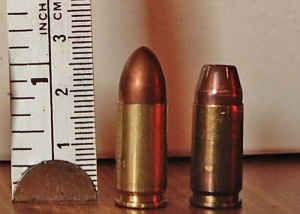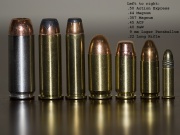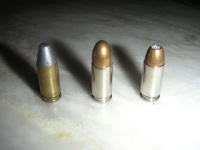9x19mm Parabellum
| 9x19mm Parabellum | ||||||||||||||||
|---|---|---|---|---|---|---|---|---|---|---|---|---|---|---|---|---|

| ||||||||||||||||
| Ball and hollow point 9 mm Parabellum rounds | ||||||||||||||||
| Type | Pistol | |||||||||||||||
| Country of Origin | German Empire | |||||||||||||||
| Specifications | ||||||||||||||||
| Parent Case | 7.65x22mm Parabellum | |||||||||||||||
| Case Type | Rimless, straight | |||||||||||||||
| Bullet Ø | 9. mm (0.35 in) | |||||||||||||||
| Neck Ø | 9.65 mm (0.380 in) | |||||||||||||||
| Base Ø | 9.93 mm (0.391 in) | |||||||||||||||
| Rim Ø | 9.96 mm (0.392 in) | |||||||||||||||
| Rim Thickness | 0.90 mm (0.035 in) | |||||||||||||||
| Case Length | 19.15 mm (0.754 in) | |||||||||||||||
| Full Length | 29.69 mm (1.169 in) | |||||||||||||||
| Rifling twist | 250 mm (1 in 9.84 in) | |||||||||||||||
| Primer | Small pistol | |||||||||||||||
| Max. pressure | 235.00 MPa (34,084 psi) | |||||||||||||||
| Production & Service | ||||||||||||||||
| Designer | Georg Luger | |||||||||||||||
| Design Date | 1901 | |||||||||||||||
| Manufacturer | everybody | |||||||||||||||
| Production Dates | 1902 to present | |||||||||||||||
| Ballistic Performance Sampling | ||||||||||||||||
| ||||||||||||||||
The 9x19mm Parabellum is a pistol cartridge introduced in 1902 by the German weapons manufacturer Deutsche Waffen und Munitionsfabriken (DWM) for their Luger pistol.[2] Because of this, it is commonly called the 9 mm Luger cartridge.[3] Its parent cartridge was the 7.65x22mm Parabellum, itself a descendant of the earlier 7.65x25mm Borchardt cartridge. The 9 mm Parabellum is commonly used in pistols, submachine guns and carbines.
The name Parabellum is derived from the Latin: Si vis pacem, para bellum ("If you seek peace, prepare for war"), which was the motto and telegraphic address of DWM.
Contents |
[edit] Development
Georg Luger developed the 9 mm Parabellum cartridge from the earlier 7.65 mm Parabellum pistol cartridge. In 1902, Luger presented the new round to the British Small Arms Committee as well as three prototype versions to the U.S. Army for testing at Springfield Arsenal in mid-1903. The German military expressed official interest in a 9 mm version of the Parabellum in 1904.
The initial cartridge was created by removing the bottleneck of the 7.65 mm Luger cartridge, resulting in a tapered rimless cartridge. The ogive of the bullet was slightly redesigned in the 1910s in order to improve feeding.
After World War I, acceptance of this caliber increased and 9 mm pistols were adopted by a number of countries.
To conserve lead during World War II in Germany, the lead core was replaced by an iron core encased with lead. This bullet, identified by a black bullet jacket, was designated as the 08 mE (mit Eisenkern - "with iron core"). By 1944, the black jacket of the 08 mE bullet was dropped and these bullets were produced with normal copper-colored jackets. Another wartime variation was designated the 08 SE bullet and identified by its dark gray jacket, and was created by compressing iron powder at high temperature into a solid material (Sintereisen - "sintered iron").
A special load (identified either by an “X” on the headstamp or by a green lacquered steel case) with a 9.7 g (150 gr) full metal jacket bullet with a subsonic muzzle velocity for use with suppressed firearms was produced by the Germans during WWII. Other countries also developed subsonic loads.
The 9 mm cartridge has been manufactured by, or for, more than 70 different countries and has become a standard pistol caliber for NATO and other military forces around the world. Its official nomenclature among NATO users is "9 mm NATO".
After WWII, the common weight of the 9 mm was changed to 8.0 g (124 gr) to increase the accuracy of the ammunition. Many police departments that use 9 mm rounds in their handguns switched to this weight after the investigation of the 1986 FBI Miami shootout, because the lighter 7.4 g (115 gr) loading used by the officers was found to be less effective than a heavier load like the 8.0 g. Bullets weighing up to 9.5 g (147 gr) are available.
[edit] Improvement
During the period between the early 1980s and the mid-1990s, a sharp increase in the popularity of "Wonder Nines" coincided with the adoption of the Beretta M9 by the US Army. At the time, most police departments were issuing .38 Special caliber revolvers with a six-shot capacity. The .38 Special was advantageous to other options like variants of the M1911 because it offered low recoil, the revolvers were small and light enough to accommodate different shooters, and it was relatively inexpensive. Possessing similar ballistics to the .38 Special revolver cartridge, the 9 mm is a shorter round, and being an autoloader cartridge is stored in flat magazines as opposed to cylindrical speedloaders or moon clips used with revolvers, ammunition carrying capacities could be easily increased by as much as 250%. The 9 mm pistol cartridge can be accommodated in a compact frame pistol, able to be used more effectively by inexperienced shooters and smaller-framed officers.
Attempts to improve ballistics of the cartridge came in the early 1990s with the widespread availability of high pressure loadings of the 9 mm cartridge. Such cartridges are labeled "+P" or in the case of very high pressure loadings "+P+". Ballistic performance of these rounds was moderately improved over the standard loadings. In addition, improvements in jacketed hollow point bullet technology have produced bullet designs that are more likely to expand and less likely to fragment than earlier iterations, giving a 9 mm bullet greater damage capability while retaining its compact cartridge size.
The .40 S&W round debuted at the 1990 S.H.O.T. show. The .40 S&W sought to fill the gap between 9 mm and .45 ACP. While increasing bullet diameter to roughly half the difference between 9 mm and .45 ACP, the .40 S&W retained the same SAAMI standard pressure load limits of the 9 mm (240 MPa, 35,000 PSI). This afforded only a 20% (typical) capacity loss when compared to the 9 mm.
[edit] Case material and design
- Brass: Since 1902, the common construction material of 9 mm cases (and indeed most cartridge casings) has been brass. For appearance, durability, or identification cases have been nickel or copper plated or painted.
- Aluminium: To conserve brass, aluminium cases have been produced since 1941 (Switzerland) and the development of that material in the use of the 9 mm has continued and is in use today. Non-reloadable aluminium-cased ammunition is manufactured by IMI in Israel under the "Samson" brand name and by Alliant Techsystems under the "CCI Blazer" brand.
- Steel: Various countries have experimented with the use of steel for the construction of 9 mm cases since WWI. Lacquered steel cases were used almost exclusively by the Germans during World War 2 with considerable success. Steel case cartridges are still being produced and are available today from Russia e.g. Wolf Ammunition.
- Other materials: Plastics have been widely used in the production of 9 mm blank ammunition by a number of countries. Plastic-case ball ammunition has been produced in experimental lots as an attempt to reduce cartridge price, as the traditional brass casing contains a high percentage of copper which has soared in price beginning in the early 2000s.
[edit] Performance

The 9 mm cartridge combines a relatively flat trajectory with moderate recoil. The main advantage lies in its being among the smallest of the "large caliber" rounds, allowing users to carry greater capacity compared to larger rounds like .40 S&W and .45 ACP. Combined with the lower felt recoil as compared to a larger round, 9x19mm-chambered handguns allow the shooter to place more shots accurately and more quickly than a handgun chambered for a larger cartridge. The "Wonder Nine" design theory, resulting in handguns like the Glock 19, is the result of attempts to maximize these advantages by more than doubling magazine capacity over comparably-sized pistols in larger calibers like the M1911. Some firearm enthusiasts consider the 9x19mm the "smallest" round suitable for personal protection, as rounds that are smaller provide less penetration and wound size, reducing the likelihood of "one-shot stops". This position is contested however; others consider the less powerful .380 ACP, popular in subcompact "pocket pistols", to be the minimum, while many "Big Hole" proponents consider the .45 ACP the standard by which other pistol rounds should be judged.
A main disadvantage of the 9x19mm is its tendency to overpenetrate flesh when poor quality expanding or non-expanding ball ammunition is used. When firing a round that does not expand, the 9x19mm produces relatively small wound cavities and reduced overall wound potential due to punching through without causing enough tissue disruption to stop the subject. This makes shot placement more critical with less than optimal ammunition, and the use of modern expanding hollow-point bullets almost mandatory for most shooters. The energy delivered by most 9 mm loads allows for adequate expansion and penetration with premium JHP bullets. The energy may be marginal for imparting hydrostatic shock in human-sized living targets,[4] though the existence of this phenomenon has been questioned, especially regarding its possibility with handgun cartridges.[5][6][7]
|
|

[edit] Synonyms
- 9 x 19 mm
- 9 mm
- 9 mm Luger
- 9 mm NATO
- 9x19mm
- 9x19mm NATO
- 9 mm Parabellum
- 9 mm Para
[edit] See also
- 9 mm caliber
- List of firearms
- List of handgun cartridges
- List of rifle cartridges
- NATO EPVAT testing
- Hydrostatic shock
[edit] References
- ↑ Federal Cartridge Co. ballistics page
- ↑ Hogg, Ian V.; Weeks, John S. Military Small Arms of the 20th Century (7th Edition), p.40. Krause Publications, 2000
- ↑ Free current C.I.P. CD-ROM version download (ZIP and RAR format)
- ↑ Scientific Evidence for Hydrostatic Shock
- ↑ The Shockwave Myth Fackler ML: Literature Review and Comment. Wound Ballistics Review Winter 1991: pp38-40.
- ↑ Patrick UW: Handgun Wounding Factors and Effectiveness. FBI Firearms training Unit, Quantico, VA. 1989.
- ↑ MacPherson D: Bullet Penetration—Modeling the Dynamics and the Incapacitation Resulting From Wound Trauma. Ballistics Publications, El Segundo, CA, 1994.
[edit] External links
- 9 mm videos
- Various photos of 9 mm Parabellum ammunition
- Extensive data on 9 mm Parabellum ammunition variations and development
- Article on 9 mm Parabellum cartridge collecting including history with photos and descriptions of variations including headstamps
|


